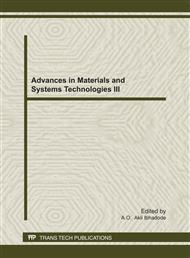p.639
p.647
p.653
p.667
p.677
p.685
p.699
p.711
p.725
Modeling Analysis of the Wire-Drawing Operation Using the Weighted-Residual Finite Element Method
Abstract:
Numerical analysis of a wire drawing operation to compute the stress distribution along the blank cross-section is presented. The governing equation describing the wire drawing equation is weakened using the Bubnov-Galerkin finite element method to obtain the finite element model. The blank is descritized into a mesh of C0 quadratic isoparametric and C0 cubic finite elements. Stiffness matrices for all elements are obtained using the finite element model which were subsequently assembled by enforcing continuity of the nodal stress. Boundary conditions are applied and the resulting condensed system of equation solved for unknown nodal stresses using Gauss Seidel method. The relative performance of the C0 quadratic and C0 cubic elements are assessed. Parametric analysis is carried out to show the influence of drawing parameters on the stresses generated and drawing load. The analysis was carried out using a Visual Basic.Net program developed by the authors.The results are presented in both graphical and tabular forms.
Info:
Periodical:
Pages:
677-684
Citation:
Online since:
October 2011
Authors:
Keywords:
Price:
Сopyright:
© 2012 Trans Tech Publications Ltd. All Rights Reserved
Share:
Citation:


